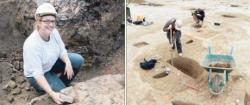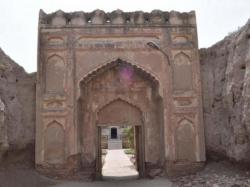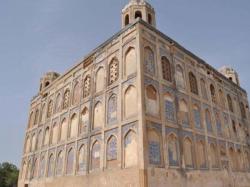- 08 AOÛT
- INDI-UNI : 
PRE-INSCRIPTION : 15 Juin – 15 Août
PRE-REGISTRATION: June 15th - August 15th
- EGYPTE – Khatabtah - The Society's expedition to Minufiyeh Governorate in the Nile Delta, direct by Dr Joanne Rowland of the Free University, Berlin, will be resuming work next week, with a survey at the desert-fringe site of Khatabtah. This area was first briefly visited by members of the Minufiyeh Archaeological Survey in 2008 with a follow-up reconnaissance survey in 2009, which established the location of many findspots – including apparently undisturbed areas – with lithic assemblages ranging in date from the Palaeolithic to, possibly, as late as the Old Kingdom. The fieldwork planned for summer 2011 will begin a systemic survey, including recording the location of, and full collection and analysis of the total content of selected grid squares in findspots located during the 2009 season. Rebecca Phillipps of Auckland University, New Zealand, will lead the survey, having established a successful methodology in Australia which has already been applied to prehistoric sites of the Fayum, and having worked on the prehistoric lithics with Penny Wilson for the EES/University of Durham mission at Sais.
http://egyptology.blogspot.com/
- ANGOLA - Mbanza Kongo - The start of archaeological works at the old capital city of Kongo Kingdom, should begin after conclusion of geophysics and historic prospecting of the city, part of efforts by the Angolan government aimed at subscribing Mbanza Kongo city in the list of world heritage. The information was passed by coordinator of “Mbanza Kongo, a city to be unburied for preservation”, Sónia da Silva Domingos, at the end of final visit of officials from national culture heritage institute and experts of Unesco to Mbanza Kongo city. According to the source, the inspection work closed to religious, traditional, academic entities and those of civil entities, should contribute to uncover more vestiges of the old city of Mbanza Kongo, which will serve as basis and argument for its classification.
http://www.portalangop.co.ao/motix/en_us/noticias/lazer-e-cultura/2011/7/31/Archaeological-works-begin-former-Kongo-Kingdom,56005f33-9a72-4704-b7e9-20084de8e259.html
- FRANCE – Sanguinet - Bernard Dubos, membre du Centre de recherches et d'études scientifiques de Sanguinet (Cress) donnait une conférence samedi dernier sur les recherches archéologiques, et tout particulièrement sur la découverte des pirogues du lac de Sanguinet. Des embarcations, richesse du patrimoine aquitain, pleines d'enseignements que les plongeurs archéologues ont sorties du secret des eaux lors de diverses campagnes de fouilles subaquatiques. Depuis une quarantaine d'années, les trouvailles exceptionnelles des chercheurs du Cress permettent de retracer l'histoire du peuplement de cette vallée recouverte par le plus grand lac landais. Il s'agit d'une occupation humaine continue de l'âge du bonze jusqu'à l'époque paléochrétienne. Sur les bords de la Gourgue, rivière dont la partie ennoyée se déversait dans l'océan avant que la formation des dunes littorales obstrue définitivement l'exutoire et donne naissance au plan d'eau, les investigations ont permis de repérer à ce jour 37 pirogues (quatre façonnées dans du chêne, les autres en pin). « En effet, précisait Bernard Dubos devant un auditoire passionné, la trente-septième vient tout juste d'être localisée il y a trois semaines. Il faut y ajouter une barque monoxyle chargée de résine qui a coulé sur le site de Put Blanc vers le XVIIe siècle à l'endroit même où se trouvait une pirogue. Cette barque médiévale est l'héritière de 3 000 ans de navigation sur le lac ». Pour les archéologues, les études réalisées permettent de penser que les piroguiers de l'époque utilisaient la voie maritime et que, pendant des siècles, ils ont effectué des échanges avec les peuples voisins installés sur la zone littorale aquitaine. Preuve en est, après avoir réalisé une pirogue à l'identique de celle exposée au musée, les essais sur le lac puis sur l'océan à partir du courant d'Huchet ont montré une très grande stabilité.
http://www.sudouest.fr/2011/08/05/3-000-ans-de-navigation-sur-le-lac-468105-3542.php
- FRANCE - Condé-sur-l'Escaut - Alain Henton, responsable du diagnostic de Condé-sur-l'Escaut, ne cache pas sa joie. L'opération s'est achevée fin juillet. Bilan : on en sait plus sur l'histoire du peuplement de la ville. « Les vestiges retrouvés sur notre site datent de la fin du XIIIe ou du début du XIVe siècle, explique Alain Henton. Cela signifie que la population a aménagé cet espace marécageux et que la ville s'est agrandie à ce moment-là. » Le diagnostic de Condé n'a pas encore livré tous ses mystères. Sur une autre parcelle, les archéologues s'interrogent sur la présence de fondations en pierre datant du XVIIIe siècle. « Il s'agit peut-être d'une caserne, suggère Alain Henton. J'ai besoin de vérifier sur les plans de l'époque mais certains sont erronés. L'archéologie urbaine, c'est un vrai puzzle ! » •
http://www.lavoixdunord.fr/Region/actualite/Secteur_Region/2011/08/07/article_les-archeologues-deterrent-le-passe-de-l.shtml
- FRANCE –  Bourlon - Sur le site archéologique de la commune de Bourlon, inutile de chercher des vieux murs ou des vestiges. Il n'y a que des archéologues s'activant autour de petites cavités. Leur but : déterminer comment vivaient les hommes aux Vie et VIIe siècles. La fouille de ce terrain, isolé en pleine campagne, se déroule dans le cadre du projet du canal Seine - Nord Europe. Sur son tracé, près d'une trentaine de fouilles sont organisées. « Mais notre site est le seul de la région où nous avons détecté une forte présence humaine datant du Haut Moyen Âge, donc des VIe et VIIe siècles, précise Thierry Marcy, l'archéologue responsable des opérations. Nous pensons qu'il s'agit d'une unité rurale, un village en quelque sorte. » Fours, sépultures, puits, silos à grains, enclos... Toutes ces traces vont permettre à l'équipe de l'Institut national de recherches archéologiques préventives (INRAP), qui gère les fouilles, de raconter l'histoire de ce site. Et les archéologues ne sont pas gênés par l'absence de vestiges : « Ils ont disparu car à l'époque, les structures étaient légères, en bois et en torchis, résume Thierry Marcy. C'est uniquement grâce à l'analyse des différentes couches du sol que nous comprenons petit à petit le passé du lieu. » L'hypothèse retenue pour l'instant : le site connaît plusieurs installations successives dès le milieu du VIIe siècle et disparaît au IXe siècle au profit d'autres villages plus importants. Ces théories seront confirmées en laboratoire, après une analyse de toutes les données récoltées.
Bourlon - Sur le site archéologique de la commune de Bourlon, inutile de chercher des vieux murs ou des vestiges. Il n'y a que des archéologues s'activant autour de petites cavités. Leur but : déterminer comment vivaient les hommes aux Vie et VIIe siècles. La fouille de ce terrain, isolé en pleine campagne, se déroule dans le cadre du projet du canal Seine - Nord Europe. Sur son tracé, près d'une trentaine de fouilles sont organisées. « Mais notre site est le seul de la région où nous avons détecté une forte présence humaine datant du Haut Moyen Âge, donc des VIe et VIIe siècles, précise Thierry Marcy, l'archéologue responsable des opérations. Nous pensons qu'il s'agit d'une unité rurale, un village en quelque sorte. » Fours, sépultures, puits, silos à grains, enclos... Toutes ces traces vont permettre à l'équipe de l'Institut national de recherches archéologiques préventives (INRAP), qui gère les fouilles, de raconter l'histoire de ce site. Et les archéologues ne sont pas gênés par l'absence de vestiges : « Ils ont disparu car à l'époque, les structures étaient légères, en bois et en torchis, résume Thierry Marcy. C'est uniquement grâce à l'analyse des différentes couches du sol que nous comprenons petit à petit le passé du lieu. » L'hypothèse retenue pour l'instant : le site connaît plusieurs installations successives dès le milieu du VIIe siècle et disparaît au IXe siècle au profit d'autres villages plus importants. Ces théories seront confirmées en laboratoire, après une analyse de toutes les données récoltées.
http://www.lavoixdunord.fr/Region/actualite/Secteur_Region/2011/08/07/article_les-archeologues-deterrent-le-passe-de-l.shtml
- ROYAUME UNI - Cranbrook - An ancient Iron Age settlement has been uncovered by archaeologists working for South West Water in Devon. It was found during an archaeological evaluation of the route of a new water mains between Beacon Hill reservoir, near Exeter, and the town of Cranbrook. Archaeologists were investigating a large prehistoric enclosure below the ground which was discovered by carrying out surveys from the air in 1996. Among the finds were shale bracelets and an iron-working furnace. Excavations showed the enclosure would originally have had a massive bank inside a ditch. James Field, South West Water's (SWW) ecologist and environmental planner, said it was an important settlement. "Someone went to a lot of trouble to construct this ditch in the days before JCBs," he said. "In the lower layers of the ditch we have found a pile of broken bracelets made of shale - an oily, soft rock. "Within the enclosure was an Iron Age iron-working furnace, which again is rare in the county. "It is probable that the shale itself comes from as far as Kimmeridge in Dorset, which poses important questions about the significance and nature of this enclosure."
http://www.bbc.co.uk/news/uk-england-devon-14428164
- PAKISTAN – 
 Hyderabad - As Hyderabad was administratively tossed about on the stormy sea of the Sindh coalition last week, August 2 marked the 239th death anniversary of the man who founded the city – Mian Ghulam Shah Kalhoro, an 18th century ruler of Sindh. For such a great ruler it is a shame that his tomb is neglected. “Heritage is as important as glorious history itself,” mused Prof. Hakim Ali Shah Bukhari, a former director of the Archaeology department.According to Bukhari, Kalhoro’s mausoleum, a 56×56 feet wide and 36-feet high monument built inside a rectangular fort, also served as the second line of defence on a northern hillock of Pucca Qila. “Its interior, exquisitely decorated with paintings, gilding, tiles and arch-shaped windows filled with terracotta grilles of geometrical and arabesque patterns, has lost its lustre.” He is also upset that the site is gradually morphing into a graveyard. “On the top of its dilapidated condition, people are being allowed to bury their dead there.”
Hyderabad - As Hyderabad was administratively tossed about on the stormy sea of the Sindh coalition last week, August 2 marked the 239th death anniversary of the man who founded the city – Mian Ghulam Shah Kalhoro, an 18th century ruler of Sindh. For such a great ruler it is a shame that his tomb is neglected. “Heritage is as important as glorious history itself,” mused Prof. Hakim Ali Shah Bukhari, a former director of the Archaeology department.According to Bukhari, Kalhoro’s mausoleum, a 56×56 feet wide and 36-feet high monument built inside a rectangular fort, also served as the second line of defence on a northern hillock of Pucca Qila. “Its interior, exquisitely decorated with paintings, gilding, tiles and arch-shaped windows filled with terracotta grilles of geometrical and arabesque patterns, has lost its lustre.” He is also upset that the site is gradually morphing into a graveyard. “On the top of its dilapidated condition, people are being allowed to bury their dead there.”
http://tribune.com.pk/story/226338/239th-death-anniversary-what-would-the-man-who-built-hyderabad-think-of-it-today/
- AZERBAIDJAN – Gulistan - The Institute of Archaeology & Ethnography of the National Academy of Sciences of Azerbaijan (AMEA) has created a website for Shemakha-Agsu archaeological expedition. According to the Institute, the website contain detailed information about the expedition, its work, excavation of Gulistan tower located in Shemakha region, the history of this tower, archaeological finds and photo/video materials, scientific articles, and information of the press about Shemakha-Agsu archaeological expedition. An expedition’s member says that through the site the scientific community will be in constant communication with the expedition to be able to answer any questions. Currently, work is underway on development of Russian and English versions of the site - www.shamakhiagsuexpedition.org.